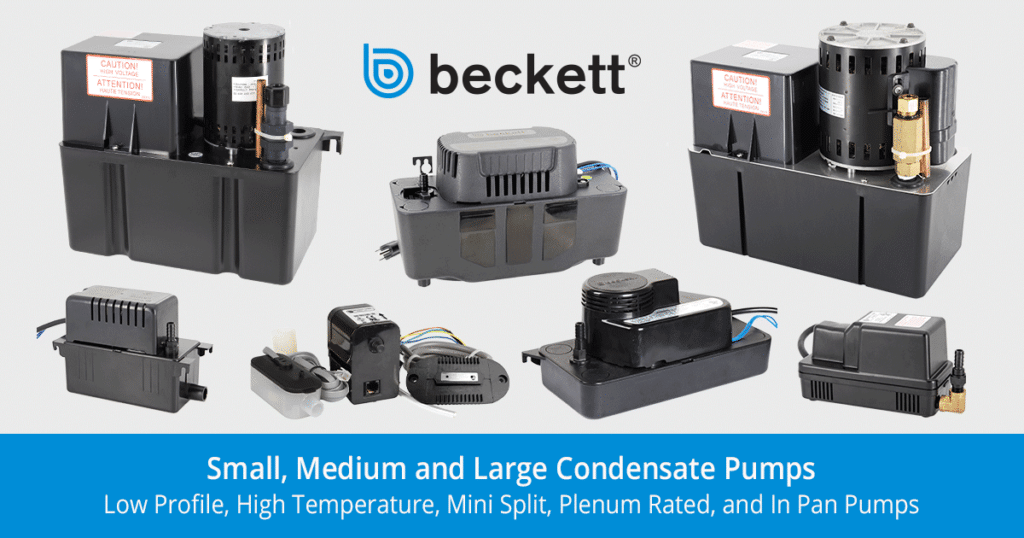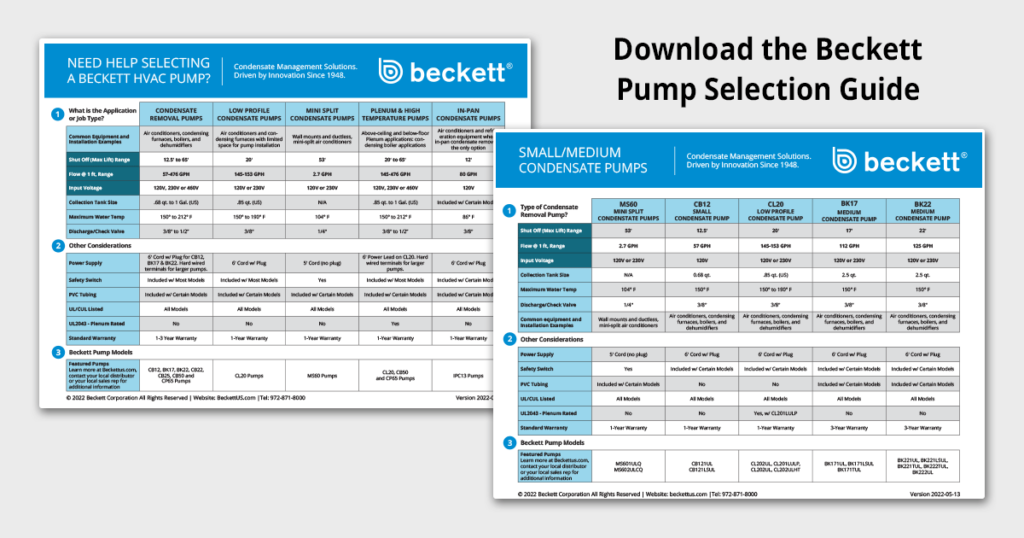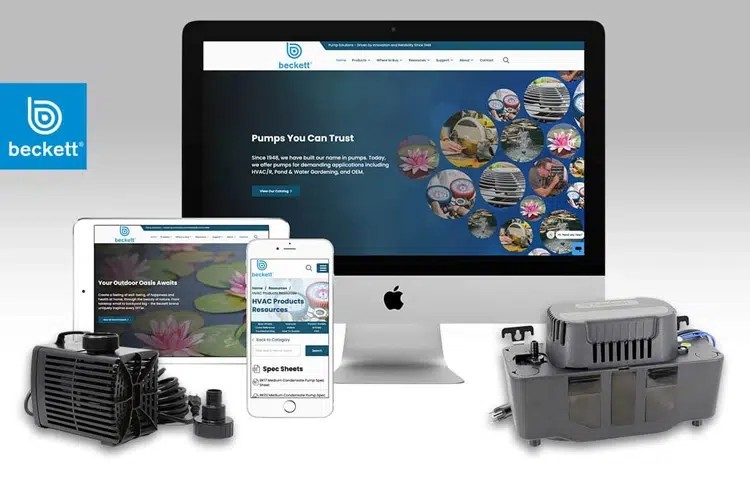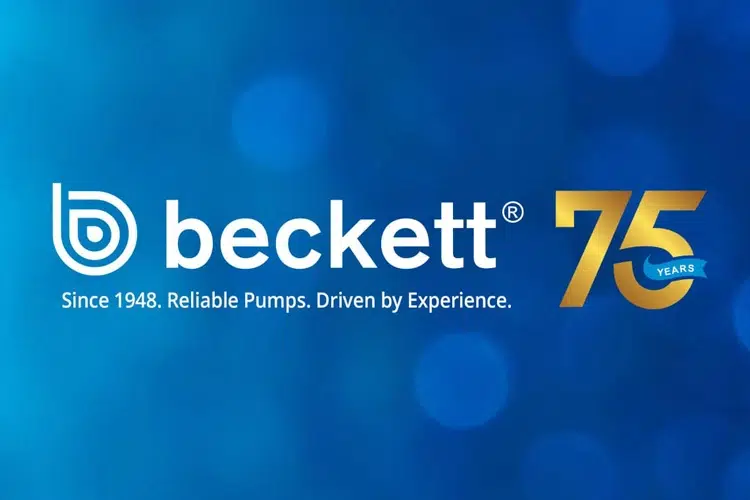Condensate Pumps for Computer Room Air Conditioning (CRAC)

This resource article dives into condensate pumps for computer room air conditioning (CRAC) and explores Beckett Corporation’s extensive experience working with OEMs of data center cooling systems to deliver stock and semi-custom condensate pump solutions for manufacturers.
When it comes to component reliability, performance, and cost-effectiveness, CRAC OEMs are continually exploring new options for major components, including condensate removal pumps.
Due to confidentiality agreements with OEMs, we are not able to share specific details on any manufacturers, models or specific application details in this article.
Key Takeaways
- Beckett has extensive experience working with CRAC OEMs
- All CRAC systems produce condensate during normal operation
- Not all CRAC systems require a condensate pump
- CRAC and CRAH cooling systems are similar but differ in their size, application and overall cost
- Beckett offers many advantages compared to other condensate pump manufacturers
Why do computer rooms and data centers need air conditioning?
Poorly managed computer room temperature, humidity, and air quality can negatively affect the performance and lifespan of computer equipment and put priceless data at risk. To protect servers and data, specialized HVAC equipment is essential to monitor and control temperature, humidity, and air quality in computer rooms, data centers, and server farms.
What is Computer Room Air Conditioning (CRAC)?
A CRAC unit is similar to traditional air conditioning equipment. It is designed to maintain the temperature, air distribution, and humidity in a data center’s computer rooms. CRAC units use a direct expansion refrigeration cycle. Air is cooled by blowing over a cooling coil. The cooling coil is filled with refrigerant, which itself is kept cool by compression. The extra heat is ejected using a glycol mix, water, or ambient air.
Why do CRAC systems need condensate pumps?
Condensate is created during a change in the state of water from a gas or vapor form into a liquid form. It generally occurs when vapor in warm air encounters a cool surface, which normally occurs in air conditioning systems, refrigeration equipment, and other types of cooling and heating equipment.
To prevent the unwanted collection of condensate water, it should be drained away by gravity through a drain pipe or hose. If gravity drainage is not possible or practical, a condensate pump is used to automatically pump the condensate water to a drainage point.
What are the main components of a CRAC Unit?
The major components of most CRAC systems can include mechanical items, monitoring/controls, refrigerants, air filters, compressors, evaporator coils, and condensate removal pumps. The actual components vary based on the make, model, and size of the CRAC system.
Are CRAC and CRAH (Computer Room Air Handlers) the same?
No. CRAH cooling units have a similar function to chilled water air handling units in buildings. Like CRAC systems, these units use fans to blow air over cooling coils to remove excess heat. However, these cooling coils are filled with chilled water rather than refrigerant. The chilled water typically comes from a separate chiller or chilled water plant. The unit draws in warm air from the computer room, and the air flows over the chilled water coils. Heat transfers from the air to the water, which then returns to the chiller. CRAH units can regulate fan speed, ensuring humidity and temperature levels stay stable while also allowing variability.
CRAH cooling is typically used in mid-to-large-sized data centers and server farms. Because CRAH units don’t use compressors, they typically use less energy, are more efficient and require less maintenance, all of which can also mean lower operating costs. However, CRAH systems include a significant capital investment because they’re designed for medium to large data centers.
Common Problems for CRAC OEMs
Beckett works with CRAC OEMs during projects related to new product development and existing product improvements. OEMs explore alternative pump solutions for a variety of reasons, including the following:
- Pump reliability and durability issues
- Pump performance problems
- Unacceptable pump operating noise
- High-temperature requirements from steam humidifiers
- Tight dimension requirements from low profile or aisle/row/rack cooling
- Plenum rated (UL2043) pumps for placement in plenums or ducts due to space limitations
- Uncompetitive pump price points
- Unresponsive or inflexible engineering and technical support
- Issues related to supply chain and product availability
- Slow time to market capabilities
Solutions & Benefits for CRAC OEMs
With over 70 years of experience, Beckett offers a range of stock and semi-custom condensate pumps to meet a wide range of applications at a cost-effective price point. With in-house engineering and production, Beckett offers a range of high-quality condensate pump solutions.
Beckett’s extensive OEM experience backed by a range of important capabilities makes Beckett condensate pumps the ideal solution for many CRAC manufacturers.
- Proven Pump Technologies – With a range of stock pump technologies, Beckett can meet different needs with proven high-quality condensate pumps at a competitive price point. In addition, Beckett can assist with control switches and integration with other control systems. The Beckett IPC13, CL20, BK22, CB25 and CB50 condensate pumps have been used in a wide variety CRAC applications including but not limited to high-temperature, plenum, and low profile applications.
- In-House Engineering – Our technical resources are available for assistance with product sizing, selection and semi-custom applications.
- In-house Production – Ensures a more reliable supply chain, lower tooling costs, faster cycle times, and overall greater flexibility to meet your needs.
- Time to Market – Beckett understands the need for speed and flexibility. Our in-house capabilities shorten cycle times and lead times to give our OEM customers another advantage.
- Production Tooling – In rare cases where custom tooling is needed, Beckett offers more affordable tooling and shorter lead times to help keep costs down.
- Experience – Since 1948, Beckett has built a proven track record for producing high-quality pumps known for reliability, long-term durability, quiet operation, and great overall value.
Download the Beckett Pump Selection Guide
Getting Started with Beckett OEM Pumps
To learn about Beckett’s OEM products and capabilities, please contact Allen Jerkins, National Sales Manager – OEM, or call 866-466-4319.






